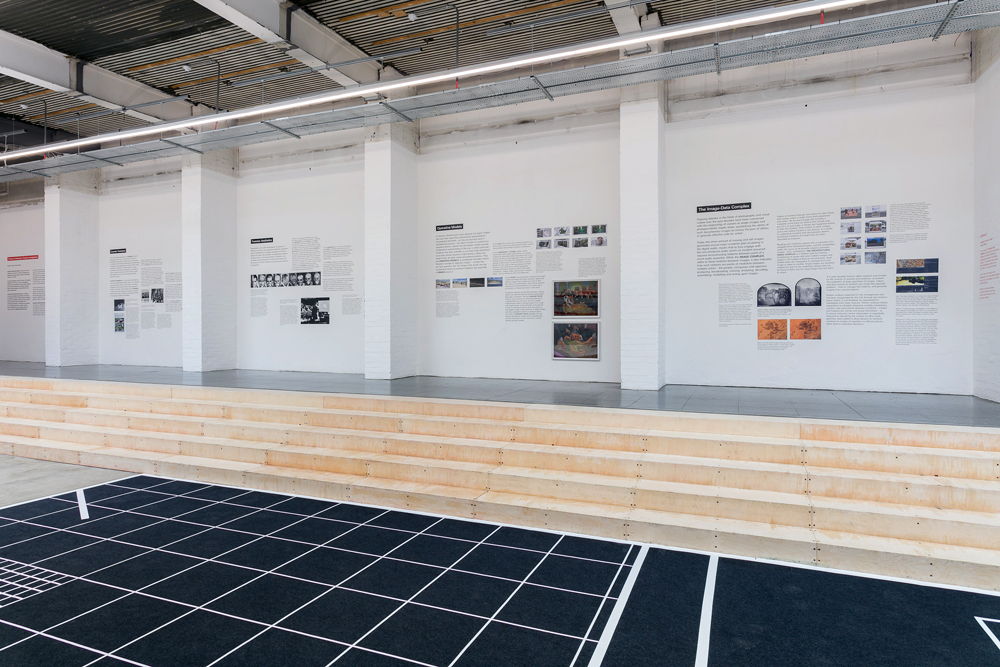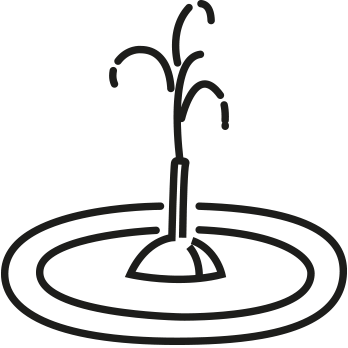
In Counter Investigations: Forensic Architecture, the ICA opens up as a site for enquiry – both as a record of inquiries undertaken by the independent research agency Forensic Architecture, and as a space of study for the public. The ICA itself is undergoing a period of renovation, and it’s core structure – from grand, detailed cornices, to internal wiring and insulation – forms the backdrop to Forensic Architecture’s investigations. The exhibition stretches through the lower and upper galleries, as well as the theatre space and reading room; and is very much focused on collective experience – facilitated via scale, access, seating and sound, as well as a programme of short courses and debates.
The agency was established in 2010, by British-Israeli architect Eyal Weizman. His critical practice initially took form in a PhD on the ways in which town planning in the occupied territories was used to divide and suppress, and a censored exhibition on settlements, which went on to be shown at the Israeli pavilion in the Venice architecture biennale. Weizman wanted to show how architects could be complicit in human rights violations by architecture and planning; and although the work of Forensic Architecture now extends far beyond the slow violence of architecture and into the rapid violence of warfare and displacement, architectural practice – actual, virtual and cognitive – is still at its core.
As the extensive wall texts of the exhibition describe, the word ‘forensic’ derives from ‘forensis’, Latin for ‘pertaining to the forum’. The Roman forum was “a multi-dimensional space of politics, law and economy”, and the centre of day-to-day life in ancient Rome – a marketplace, and the venue for public speeches, criminal trials and gladiatorial matches. This definition is in stark contrast to the contemporary understanding of forensics as “the application of science within a legal framework”: “Extending from DNA analysis to image surveillance and digital eavesdropping, contemporary forensic practices provide one of the means by which state agencies survey, police and judge individuals under their control.”
Counter forensics, as undertaken by Forensic Architecture, is: “a civil practice that seeks to invert the institutionalised forensic gaze, with individuals and organisations making over the means of evidence production, and turning the state’s means against the violence it commits.” The agencies practice employs spatial and material analysis, mapping and reconstruction, witness testimony and visual documentation from blogs and social media, to produce and present evidence in the pursuit of public accountability. The work on display is complex and demanding, and deals with distressing, urgent cases; the video works are compelling and the exhibition is striking as a spatial intervention, but at points the extensive texts draw too much attention away from the work itself. With so much to address, in terms of subject, process and context, the information is by no means superfluous, but could do with being presented in another form. It’s at the points where the information is shown – such as in the mural flow diagrams – that it achieves real clarity, and in the engagement with the public through the aforementioned short courses and debates. It’ll be here that Counter Investigations: Forensic Architecture will not only counter the contemporary definition of forensics, but embody the Latin origin of the term with its focus on the public.
The exhibition presents multiple investigations – which have lead to the contestation of accounts of events given by state authorities, affecting legal and human rights processes, and military, parliamentary and UN inquiries – each one an open-ended process, and here set on the stage of a public forum, the ICA. The role and position of public arts institutes, their civic responsibility and potential impact, has long been in question – or questioned. Here, the ICA and Forensic Architecture have presented a form that could be translated to countless cases – the gallery as a forum, a place for debate and the pursuit of public accountability.
Spring, 2018
The agency was established in 2010, by British-Israeli architect Eyal Weizman. His critical practice initially took form in a PhD on the ways in which town planning in the occupied territories was used to divide and suppress, and a censored exhibition on settlements, which went on to be shown at the Israeli pavilion in the Venice architecture biennale. Weizman wanted to show how architects could be complicit in human rights violations by architecture and planning; and although the work of Forensic Architecture now extends far beyond the slow violence of architecture and into the rapid violence of warfare and displacement, architectural practice – actual, virtual and cognitive – is still at its core.
As the extensive wall texts of the exhibition describe, the word ‘forensic’ derives from ‘forensis’, Latin for ‘pertaining to the forum’. The Roman forum was “a multi-dimensional space of politics, law and economy”, and the centre of day-to-day life in ancient Rome – a marketplace, and the venue for public speeches, criminal trials and gladiatorial matches. This definition is in stark contrast to the contemporary understanding of forensics as “the application of science within a legal framework”: “Extending from DNA analysis to image surveillance and digital eavesdropping, contemporary forensic practices provide one of the means by which state agencies survey, police and judge individuals under their control.”
Counter forensics, as undertaken by Forensic Architecture, is: “a civil practice that seeks to invert the institutionalised forensic gaze, with individuals and organisations making over the means of evidence production, and turning the state’s means against the violence it commits.” The agencies practice employs spatial and material analysis, mapping and reconstruction, witness testimony and visual documentation from blogs and social media, to produce and present evidence in the pursuit of public accountability. The work on display is complex and demanding, and deals with distressing, urgent cases; the video works are compelling and the exhibition is striking as a spatial intervention, but at points the extensive texts draw too much attention away from the work itself. With so much to address, in terms of subject, process and context, the information is by no means superfluous, but could do with being presented in another form. It’s at the points where the information is shown – such as in the mural flow diagrams – that it achieves real clarity, and in the engagement with the public through the aforementioned short courses and debates. It’ll be here that Counter Investigations: Forensic Architecture will not only counter the contemporary definition of forensics, but embody the Latin origin of the term with its focus on the public.
The exhibition presents multiple investigations – which have lead to the contestation of accounts of events given by state authorities, affecting legal and human rights processes, and military, parliamentary and UN inquiries – each one an open-ended process, and here set on the stage of a public forum, the ICA. The role and position of public arts institutes, their civic responsibility and potential impact, has long been in question – or questioned. Here, the ICA and Forensic Architecture have presented a form that could be translated to countless cases – the gallery as a forum, a place for debate and the pursuit of public accountability.
Spring, 2018
Originally published by Spike Art Magazine.

